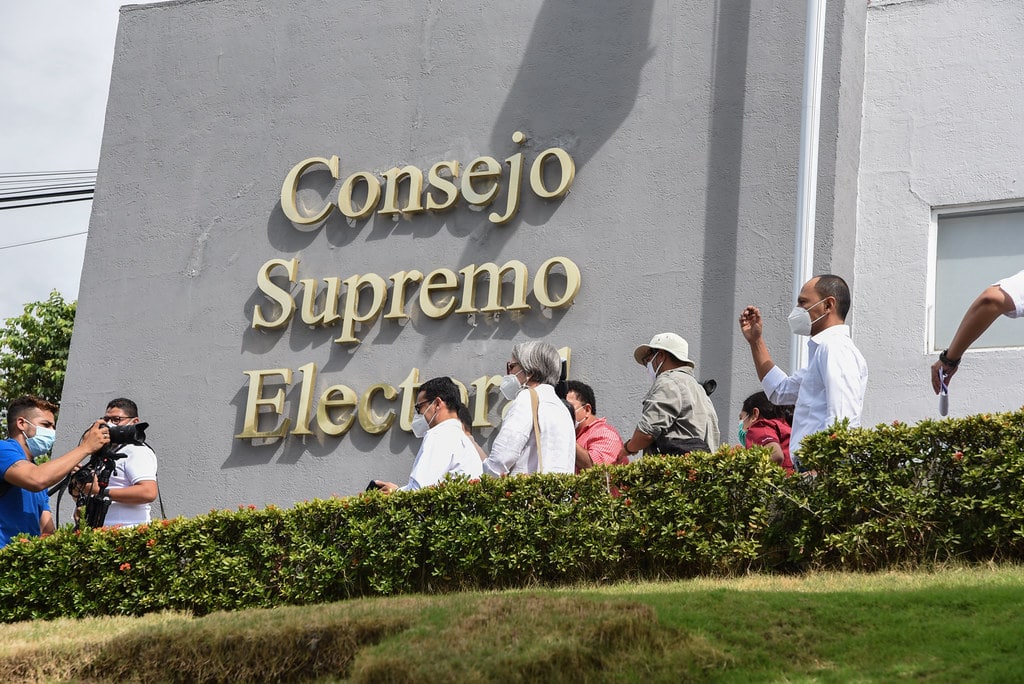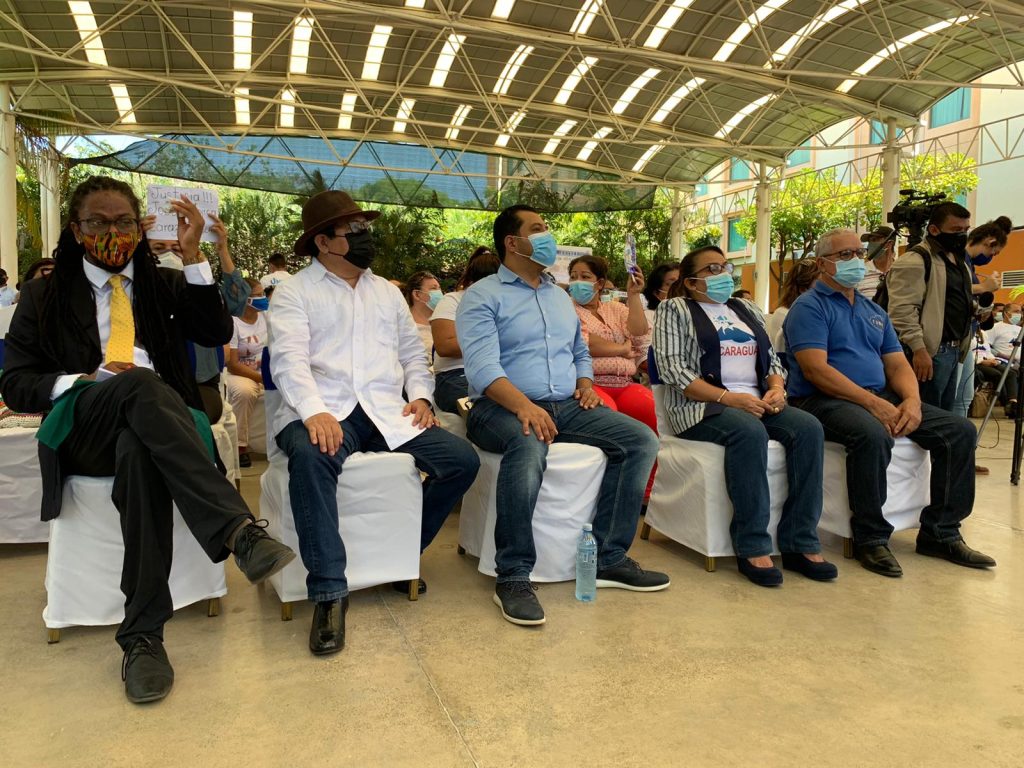19 de agosto 2021

News About Sheynnis Palacios Not Covered by Media Operating in Nicaragua

PUBLICIDAD 1M
PUBLICIDAD 4D
PUBLICIDAD 5D
Internal purges, ideological sectarianism and political contamination by parties linked to Ortega's government ate away of opposition unity

Internal purges
The cancellation of the legal status of the political party Ciudadanos de la Libertad (CxL) by the Supreme Electoral Council (CSE), controlled by the Sandinista Front, meant the final blow of the Ortega regime against the opposition that intended to confront it at the polls this November 7.
This left the presidential ticket of Daniel Ortega and Rosario Murillo on the road to an electoral process directly controlled by their representatives in the CSE and without political contenders, since the scenario of the elections left the Sandinista Front competing only against five political parties with a long history of collaboration with the red and black party.
The cancellation of CxL is added to other repressive acts of the regime against the opposition, with the purpose of removing it from the electoral scenario, such as the arrest of seven aspiring presidential candidates, among them those leading the opinion polls, and the elimination of other legal entities, like that of the Democratic Restoration Party (PRD), which housed the political forces grouped in the National Coalition, the other opposition platform seeking to influence the electoral process.
However, analysts consulted estimate that the regime's repressive escalation was also facilitated by the lack of a solid opposition unity to face Ortega's regime, and was also fed by ideological sectarianism and political ambitions of members grouped in the opposition forces.
It was evident that “the return of democracy to Nicaragua was never put above any political ambition of the opposition”, reflects a political analyst who asked for their identity to be omitted for fear of reprisals.
The fractures between the forces were mainly concentrated in those organizations that emerged as a result of the April Rebellion of 2018: the Civic Alliance for Justice and Democracy, the National Blue and White Unity (UNAB) and the National Coalition; and the political parties that appeared as probable electoral vehicles: CxL and the PRD.
The fracture between these organizations led the Civic Alliance and CxL to integrate the opposition platform Citizen Alliance, while the UNAB, other political parties and the Peasant Movement remained in the National Coalition, with the PRD ballot box as an option.
However, all these organizations face criticism for being unable to pick up and harbor the spirit of the massive marches and citizen protests of 2018, which demanded the exit from power of the Ortega and Murillo binomial.

CxL authorities leave the Supreme Electoral Council after registering their electoral alliance. Photo: Nayira Valenzuela.
According to a political analyst linked to the leadership of one of these opposition platforms, who requested anonymity due to the repressive environment in Nicaragua, if one had to define the root of the opposition failure in a simple way, it would be the inability to achieve unity against the regime.
He defines three concrete facts that demonstrate the political fracture of the opposition from his perspective: the departure of the Civic Alliance from the organizations grouped in the UNAB and the Peasant Movement, the withdrawal of the Civic Alliance from the National Coalition and finally the inability of the PRD and CxL to reach an agreement of electoral unity.
“It was painful when the Civic Alliance separated from the UNAB, but at least at the time it was still said that it could be the best thing for each organization to have its own identity, but frankly I did not expect the serious problems of unity that we saw,” said the political analyst.
Subsequently, the figure of the National Coalition was created, an opposition platform that sought to group together all those political and civil forces that oppose the regime, in order to develop a political project and a single candidacy to face the Sandinista Front in the November elections. However, this project still fell apart due to internal struggles and the ensuing decapitation by the regime.
“When the Civic Alliance decided to leave the National Coalition, that was a second mistake, but it was more serious. If we had had a well-united, strengthened opposition, it could have been a retaining wall for everything that followed. But there were many sectors in the Civic Alliance that insisted that they no longer wanted anything to do with the Coalition, because they simply preferred to join CxL”, he added.
CxL always refused to join the Coalition, citing ideological and sectarian arguments because of the presence of personalities or organizations linked to the left or called “progressive” within the opposition platform.
Another argument was that they did not need to be part of the Coalition because CxL had its own legal status and they were not willing to hand it over or share it with political forces outside the party.
The departure of the Civic Alliance from the Coalition provoked the first great loss of figures and personalities in the organization, mainly of the then general coordinator, the renowned educator and former diplomat, Carlos Tünnermann Bernheim.
Later, the Alianza Cívica integrated with CxL and created the Alianza Ciudadanos por la Libertad (Citizens for Liberty Alliance), counting on the 15th box of this political party, while the National Coalition bet on the 14th box of the PRD. This divided opposition scenario was aggravated by the failure of all these organizations to achieve electoral unity.
“The last great mistake was when electoral unity was not achieved, and the main group hindering unity was CxL, mainly Mrs. Kitty Monterrey. There is no doubt about that. What this generated was a division, a confrontation of all sorts with reciprocal attacks, and the regime took advantage of it all”, said the analyst.
Monterrey, now exiled in Costa Rica, was forced to leave the country due to threats of being imprisoned or deported after the regime practically disappeared all documentation of her Nicaraguan nationality, leaving her as an American.
The legal persecution against Monterrey was parallel to the cancellation of CxL's legal status. In the same resolution in which the CSE announced CxL's exit from the elections, it also informed that Monterrey's Nicaraguan identity card had been annulled.
Once in Costa Rica, the president of CxL gave an interview to the Channel 7 program, Telenoticias, in which she was asked about the failure of the opposition unity. She alleged that the problem with the National Coalition is that it did not have a base, because it was built “from the top down”. She said the party’s refusal to accept another opposition ballot box, other than the CxL ballot box, was “because we preferred not to get into the problem”.
“This is the third party to be taken away from us. We have been opposition for 16 years with a solid and properly structured base. Unfortunately, when the National Coalition and the different organizations were formed, they were national level organizations without a broad structure, a base that could really become an organization that faces a dictatorship. (...) It’s not that we did not want unity, it’s that we preferred not to get into a problem, and in the end we were right, it fell apart. And we had the doors open for them to join in an alliance”.

Presentation of the aspiring presidential candidates of the National Coalition. //Photo: Courtesy
In the case of the National Coalition, the internal fracture of this opposition platform began with the incorporation of parties with a gray political past, as is the case of the Constitutionalist Liberal Party (PLC) and its history of pacts and political partnership with the Sandinista Front, or the PRD itself, pointed out in the past of being a collaborator of Ortega's government.
The negotiations on whether or not to include the political parties in the National Coalition demonstrated the ideological differences between the two opposition platforms, as well as the political interests of some of their leaders.
The formation of the Coalition began to take shape during two meetings in El Salvador, in October and November 2019, respectively. Representatives of UNAB and the Alliance participated in the meetings, according to two members of both delegations, who spoke on condition of anonymity.
“Prior to the October meeting, the possibility of fighting for a new party was raised within the UNAB, there were people and time to do it. However, from the Alliance, it was indicated that there was already a party, the CxL”, stressed one of the sources.
In view of the position of the Alliance, the PRD began to be talked about within the UNAB, but there were suspicions because it was “suspected” to be a “collaborator” of the FSLN. “Each group had a political party of predilection, there were even small groups that also thought about the Conservative Party of Alfredo Cesar”.
The other source detailed that during the last meeting in El Salvador, an agreement was reached to consolidate a “foundational nucleus”, before inviting the political parties, and to do it “gradally and with great care”.
“Surprisingly, returning from El Salvador with this agreement, the Civic Alliance arranged and made appointments unilaterally with some political parties, including the PLC. At UNAB we were very upset, but we decided not to put an end to the talks and the effort for unity, since we knew how important it was for the country,” the source commented.
“That decision of the Alliance, which we finally accepted, created some difficulties for us, which UNAB had to face within the Coalition, because the Civic Alliance withdrew very soon”, they added.
The exit of the Alliance officially occurred due to some differences with the integration of the PLC into the Coalition. However, the sources pointed out that it was driven by the refusal of CxL to “integrate to the Coalition”.
“Since the first trip to El Salvador, there was already a rapprochement between the Alliance and the CxL; which is why the UNAB was in a constant quarrel, because they feared that (from within the ACJD) they were already preparing the ground to go to CxL”, said one of the participants in those meetings.
For the opponents, the inclusion of political parties brought more problems than benefits, since their presence “undermined” the trust between both opposition blocs.
“The argument of those in favor (of including the parties) was that (they) would not register with rules in whose formation they had not participated. However, if we had already had the rules defined in the founding group and a more thought-out inclusion procedure, finding one or several political parties willing to play those rules could have been good”, explained one of the sources.
“Not so much due to the issue of the ballot box, which at the end of the day are all in Ortega's hands, but to join efforts among those of us who had some structure, whether political or social,” he added.
Another political analyst who also requested anonymity to protect his safety pointed out that one of the reflections of the political division among the opposition was what he called the “wave of presidential candidates”.
Between the Alianza Ciudadana, the National Coalition and independently, there were eleven aspiring presidential candidates, without taking into account those registered before the Supreme Electoral Council (CSE) by the five political parties collaborating with Ortega’s government. Eight of these candidates are now imprisoned by the regime.
“They all had the right to be aspiring presidential candidates, but there were too many of them. Besides looking bad politically, because the first thing people say is that they want to be president and put their own aspirations first rather than the return of democracy, it reflects the lack of consensus among the opposition to achieve a single opposition candidate, which was the best way to confront Ortega. And to achieve this, it would have been enough to take the four candidates who had the greatest acceptance among the population as a base”, the political analyst said.
On May 12, the electoral registration of the Citizens' Alliance for Liberty took place, thus sealing the failure of the opposition unity with the PRD and the National Coalition. A week later, the regime began its repressive wave with the new assault on the recording studio of the programs Esta Semana, Esta Noche and Confidencial.
To date, more than 30 new political prisoners have been registered as a result of this new repressive wave, including aspiring presidential candidates, opposition leaders, journalists, student leaders, leaders of the Peasant Movement and businessmen, while Ortega's government continues to hold elections lacking legitimacy and political competition.
This article was originally published in Spanish in Confidencial and translated by our staff
Archivado como:
PUBLICIDAD 3M
Confidencial es un diario digital nicaragüense, de formato multimedia, fundado por Carlos F. Chamorro en junio de 1996. Inició como un semanario impreso y hoy es un medio de referencia regional con información, análisis, entrevistas, perfiles, reportajes e investigaciones sobre Nicaragua, informando desde el exilio por la persecución política de la dictadura de Daniel Ortega y Rosario Murillo.
PUBLICIDAD 3D